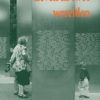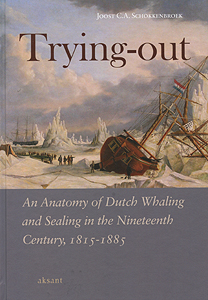Terug/Home/Webwinkel ramsj.nl /Geschiedenis/Trying-out
Joost C.A. Schokkenbroek
Trying-out
an anatomy of Dutch whaling and sealing in the nineteenth century, 1815-1885
€ 29,90 Oorspronkelijke prijs was: € 29,90.€ 7,90Huidige prijs is: € 7,90.
ISBN: 9789052602837. Bindwijze: geb Taal: EN Uitgever: Aksant Auteur: Joost C.A. Schokkenbroek Paginas: 366 Categorie: Geschiedenis.
‘Trying-out’ describes and analyses a wide array of initiatives leading to the hunt, by Dutch whalemen, of whales and seals in Arctic waters, the temperate zones of the South Pacific and the waters of the Dutch East Indies during the major part of the nineteenth century (1815-1885) – an era neglected so far. Schokkenbroek, curator at the National Maritime Museum Amsterdam, focuses on the men involved in the two maritime industries – be it on shore or aboard the whaleship.
Gerelateerde producten
geschiedenis

Wout van der Toorn
Logbook of the Low Countries
Logbook of the Low Countries' provides a concise chronicle of Belgium, Luxembourg and The Netherlands, setting their major roles against events in world history, together with famous quotations and highlights from art and science. This Logbook is meant for members of the corps diplomatique, expatriates, students from international schools and tourists, giving them easy access to the fascinating history of the country in which they reside. The struggle for political and religious freedom from Spanish domination in the sixteenth century led to the creation of the first democratic republic in the northern Netherlands which, in turn became a model for other countries. In the seventeenth century the Dutch Republic, comprising the Seven Provinces and their colonies, became the world's chief maritime trading power, only overtaken by Great Britain in the eighteenth century. More recently the Low Countries were at the forefront of European cooperation, first in the formation of the Benelux and later in the creation of the European Union, its capital Brussels and the euro. 10Stuksgeb - 240 blz
geschiedenis
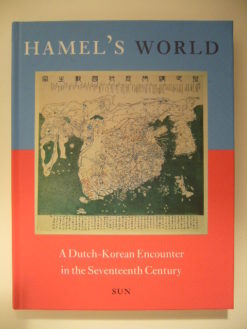
Vibeke Roeper
Hamel’s World
In 1653 the VOC ship Sperwer smashed to pieces on the rocks off a remote Korean island. There were thirty-six survivors. The king of Korea decided that the foreigners should spend the rest of their lives in his hermit kingdom. The Dutchmen were provided with food and housing and a certain amount of freedom of movement, but had no choice but to accept their fate.After 13 years eight of them managed to reach Japan in a small, barely seaworthy boat. Hendrik Hamel¹s report on their adventures soon became available to a wider public. For two centuries it was the most important source of information about the mysterious kingdom of Korea. It continues to fascinate as a report of a meeting between two completely different cultures. In 2003, 350 years after the event, the stranding of the Dutchmen is widely commemorated in Korea.The present book includes Jean-Paul Buys' modern English translation of a complete version of Hamel's Journael. Additional chapters by Leonard Blussé, W.J. Boot, Vibeke Roeper and Boudewijn Walraven describe the world familiar to VOC employees and the strange world of the Far East which, much against their will, Hamel and his compatriots came to know so well.geschiedenis
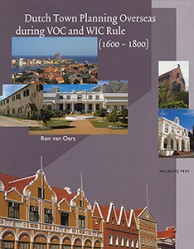
Oers
Dutch town planning overseas during VOC en WIC rule (1600-1800)
'Dutch Town Planning Overseas during VOC and WIC Rule' offers a complete overview of the Dutch-founded settlements oversea – of their origin, design and development, as well as insights into their planning and building process. Through the different typologies for settlements established by the VOC and WIC, eventually, an outline of the characteristics of Dutch colonial town planning is given. Walburg Pers212 blz
geschiedenis
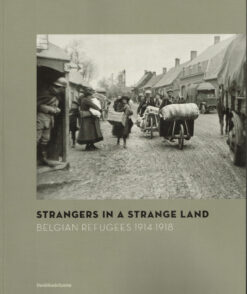
Strangers in a Strange Land
Flight. Risking the loss of all your worldly goods. Leaving hearth and home in headlong panic. A traumatic experience that turns life upside down in a moment of time. That was what happened in August 1914, when the First World War broke out. The German army flattened neutral Belgium like a steamroller. About one to one-and-a-half million Belgians fled to the Netherlands, France and Great Britain. More than half a million of them had to remain in exile until the end of the War. How were the refugees received in the host Countries? Could the children go to school and the adults find work? Was there any opportunity for recreation? In short, how did the refugees live through and survive those four long years of exile? A gripping picture of the greatest exodus in the history of Belgium. 'Strangers in a Strange Land' is drawn from extraordinary documents never seen before, from museums in Belgium and abroad, private archives and libraries; the personal witness of refugees and those who helped them, letters, diary entries. Poignant photographs add painful reality to this tragic exodus of people. A compelling record of its time. Davidsfondspap - 144 blz
